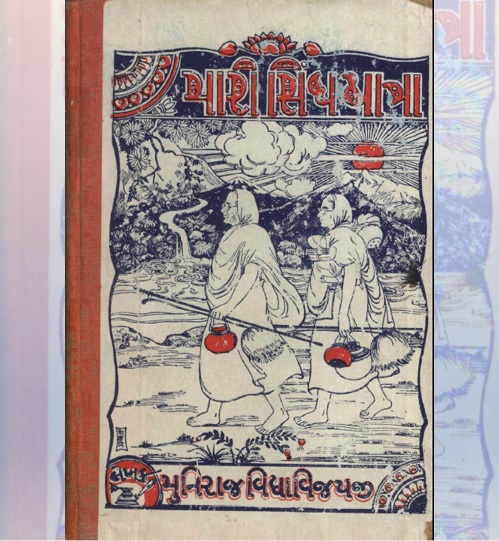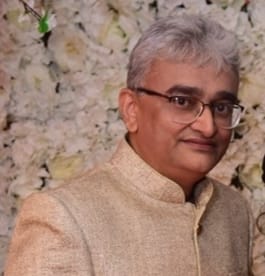
Before partition, Karachi was the house to the latest technology and machinery
[Editor’s Note: This is Part 19 (The Origination of Karachi) of a series of articles based on a pre-partition book named “મારી સિંધ યાત્રા” (“منهنجي سنڌ جو سفر”) in Gujarati authored by Jain sadhu Shri Vidyavijayji, narrating his experiences of travel and stay in Karachi for about 2 and a half years between 1937 and 1939. It would be advisable to click on the Introductory Article and read it to better understand the series. – Nasir Aijaz, Editor Sindh Courier]
Vimal Shah, Mumbai
Karachi
Karachi is the capital of Sindh. In the words of Sir Charles Napier ‘It’s the Glory of the East, Port of Punjab, and Liverpool of Hind,’ and in the words of the great poet Nanalal ‘Karachi is the gateway of India’.
The future of Karachi predicted by Nanalal 10 years ago:
“Karachi! Giant aeroplanes of the 20th century would fly from your soil. They would cross over the skies of Asia and Europe. And this would not be a poetic expression, nor imagination, nor part of stories of the wonderland, but they would be real stories of the current era. It would be ten times bigger than the giant leap from your shores. It would be recorded in history, not as imagination but as reality.”
The small village with just about twenty to twenty-five hutments once upon a time has grown into one of the most captivating cities in India
The predictions of the great poet have turned real today. Karachi is the airport connecting with the world.
The Status of Karachi
Despite being ranked 5th among the cities of India, the capital of Sindh leads in beauty and cleanliness. With a population of merely three to three and half a lacs, this city is spread across a wide land. Every road in Karachi, the series of buildings in Karachi, and the pleasant air in Karachi are charming even for the ones who have roamed around the entire Hindustan. The small village with just about twenty to twenty-five hutments once upon a time has grown into one of the most captivating cities in India.
Many settlements come up and become very successful too, but the foundation of Karachi must have been laid by a gentleman on an auspicious day
The stinking port ‘Ghadbo Bandar’ of the past has turned into a world-famous elegant seaport welcoming hundreds of steamers. Many settlements come up and become very successful too, but the foundation of Karachi must have been laid by a gentleman on an auspicious day and time such that it has become world famous today. It is said that this new avatar of Karachi and its beauty is a result of the wisdom of Jamshed Mehta. The consistent efforts of Jamshed Mehta for the city while being the chairman of the Municipality for twelve years without break would be written in history with golden words.
There’s a specialty about the origination of Karachi. Therefore, it would not be misplaced to dive into the history of Karachi.
The Origination of Karachi
History says thus concerning the origination of Karachi:
“This was a settlement of only twenty to twenty-five hutments. ‘Kalachi’ was the leader of this Goth known as ‘Kalachi-jo-Goth’. The merchants of ‘Khadak’ village on the western banks of Hub River started living near the harbor since the sand was obstructing their maritime trade. That time it was named ‘Kalachi-jo-Kun’. When the population started growing, a sandstone fort was built. The fort had two gateways, one in the North and the other in the East. They were named ‘Kharo Darwajo’ and ‘Mitho Darwajo’ – the places are known as ‘Kharadhar’ and ‘Mithadhar’ today.”
Lieutenant John Porter invented this ‘Krochi Town’ in 1774-75. It is said that ‘Balochi’ changed over time to ‘Lochi – Krochi – Karachi’. This settlement was awarded to the Balochis by the Kalhora dynasty of Sindh. It is recorded in history that Hindu merchants developed it. Talpurs conquered this village in 1795. In 1834 the commander of Talpurs fired gun salutes from the ‘Manora’ hills in honor of the British army when they arrived at the shores of Karachi on their way to Afghanistan via Sindh for a battle with Russia. The British army misunderstood it as a war cry, so they too fired gunshots in response. The Sindhis ran away because of this, and the British army captured Karachi. Later it went on developing during the British rule.
One Legend
There’s one legend too associated with the origination of Karachi.
The duo of Mirjadas (Mirzada) of the Mir of Hyderabad loved beautiful women. Once their barber told one of them ‘I have seen many beauties but none like the daughter-in-law of the Nagarsheth Naumal Bhojwani’. Both the Mirjadas determined to assault the females in the house of Naumal. The Mirjadas entered the house of Naumal in the evening. Naumal Sheth was at the warehouse, but his brother Jeevatray understood the intentions of the lads. With the help of a loyal servant, he tied both the Mirjadas in the house and killed their bodyguard. Jeevatray escaped from Hyderabad with his family and treasures on twenty-five warrior camels and reached the ‘Ghadbo Bandar’ of the Talpurs overnight. The Mirjadas were rescued by the Mir the next day. Naumal defended a lot but eventually, he was punished to dig graves in the graveyard. Naumal was a clever Sindhi. Luring the warden, he escaped and came over to ‘Ghadbo Bandar’. When the Mir asked the warden, he replied ‘Hanuman, the deity of Hindus came from the skies and carried away Naumal. When I tried to hold on to him, I too got lifted in the air. Then that kafir deity knocked me down to the ground’. The Mir did not have a choice but to be satisfied with the explanation.
The Talpur ruler’s Mirzadas had entered the house of Naumal with an intention to assault the females
On the other hand, Naumal and Jeevatray both brothers decided to take help from the British. Jeevatray met the Governor of Bombay. It is said that the British army reached ‘Ghadbo Bandar’ trusting both the brothers and concurred ‘Ghadbo Bandar’. It is said that the Kathiyawadi Lohana merchants of the ‘Jodiya Bazar’ had supplied the stores.”
There was one obstacle in the development of this village, and that was a Balochi lady from Kalat who possessed huge land over there on which she was raising hundreds of cattle. ‘Ghadbo Bandar’ could grow into a town only if she vacates the land. They offered money and alternative land to the lady, but she kept on saying ‘Aaun Kalantchi – Kalantchi’ in her dialect and said, ‘I am a martial lady, and I will not vacate’. The commander assured her that this place would be named ‘Kalatchi’ after her and she happily vacated the land. Since then, this place was named Kalatchi – Kalachi – Karachi. The original name ‘Ghadbo Bandar’ is still used in the books of accounts of the merchants.
The Metropolitan City of Gujarat!
It is said that 100 years ago when British rule began, the population of this city was just about eight to nine thousand only. Along with the port, the facilities for trade and infrastructure kept developing and so did the population. Today the population is about three lacs, out of which about one lac are Gujaratis. The fact that how well Gujaratis have established themselves in this capital of Sindh cannot be hidden from anyone who knows the city a bit. Despite being the capital of Sindh, Karachi would appear more like a metropolitan city of Gujarat. You find Gujaratis anywhere and everywhere. The significant number of Gujaratis in the markets, municipality, and many such prominent places would be evident. Likewise, the brains of Gujaratis working in every arena would also be evident.
The Gateway to Asia
The port of Karachi is thriving. The trade with every small and big port in Hindustan as well as direct import and export to other nations is through this port. And that’s the reason the port of Karachi is known as the Gateway to Asia. The airport is on Drigh Road which has connectivity to Mumbai, Madras, Calcutta, etc. and every part of the world. Nowadays even the postal services have started using the airways.
Educational Institutes
The Municipal School Board and the District Local Board are the primary administrators of the education department. The chairman of the education department of the Municipality, Shri Anant Hari Lagu is a very scholarly and astute officer as well as a gentleman. The Government runs the English medium schools beyond the fourth standard.
The port of Karachi is thriving. The trade with every small and big port in Hindustan as well as direct import and export to other nations is through this port
There are colleges in Karachi. There are High Schools. In addition to the Government and Municipal schools, there are several private and community-run schools. It is said that Sindh has supplied teachers in large numbers to the Education Department of Hindustan.
Karachi is also a house to the latest technology machinery.
The Places of Interest
Madha Peer, Manora, Hawa Bandar, Extension, Hill, Gandhi Garden, Bhootkhana, Museum, Kiyamari, Malir, etc. are the prime places of interest in Karachi.
The ‘1931 Karachi Adhiveshan’ is one of the most important historical events that took place in Karachi. The ground where the Adhiveshan met is Gujarat Nagar now.
Overall Karachi enjoys a better ranking concerning its winds, beauty and cleanliness as compared to other cities. (Continues)
Click here for Part-I, Part-II, Part-III, Part-IV, Part-V , Part-VI , Part-VII , Part-VIII , Part-IX, Part-X, Part-XI, Part-XII, Part-XIII , Part-XIV, Part-XV, Part-XVI , Part-XVII, Part-XVIII
_________________
About the contributor of the series of Articles based on the book
 Vimal Shah is a follower of Jainism by birth and is based in Mumbai, India. He is a Computer Engineer and holds a Diploma in Jainology from Mumbai University. He has an immense interest in reading, writing, studying, and teaching Jain Philosophical subjects. He conducts classroom as well as online sessions on Jain Philosophical courses. He continues to study various subjects and remains a student of Jain Philosophy. He has significantly contributed to the Translation Project of the ‘Compendium of Jainism’ from English to Gujarati – an initiative of the JAINA India Foundation. He is also associated with a Project for the translation of Jain Aagams (Scriptures) from Gujarati to English. He has a special interest in the history and preservation of the Jain Heritage in Pakistan. He was part of a Delegation of the Jain Heritage Foundation, New Delhi that visited various Jain Heritage Sites in Pakistan in May-2023.
Vimal Shah is a follower of Jainism by birth and is based in Mumbai, India. He is a Computer Engineer and holds a Diploma in Jainology from Mumbai University. He has an immense interest in reading, writing, studying, and teaching Jain Philosophical subjects. He conducts classroom as well as online sessions on Jain Philosophical courses. He continues to study various subjects and remains a student of Jain Philosophy. He has significantly contributed to the Translation Project of the ‘Compendium of Jainism’ from English to Gujarati – an initiative of the JAINA India Foundation. He is also associated with a Project for the translation of Jain Aagams (Scriptures) from Gujarati to English. He has a special interest in the history and preservation of the Jain Heritage in Pakistan. He was part of a Delegation of the Jain Heritage Foundation, New Delhi that visited various Jain Heritage Sites in Pakistan in May-2023.